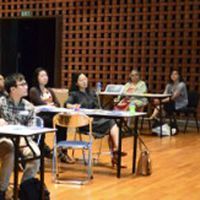The Missing Link Between Singaporean Films and Cultural Arts

The connection between films and arts form an important cultural link that is often interchangeable and essential to the growth of the arts scene, yet this connection is constantly overlooked in Singapore’s vision towards a more cultured society due to political-economic agenda.
Singapore reported history dates back to the 11th century and has strong cultural influence from The Straits Settlement, which accounts for the surge of Malay feature films produced during the 50s. After independence in 1963, the language policy on the four national languages (English, Mandarin, Malay, Tamil) was implemented in view of the rising economy of China, India and Indonesia, and other languages were categorised as “dialects”.
In a country populated by a diversity of languages and cultures, one must first ask what truly defines as Singapore culture. So far, there is no consensus on what is a “Singapore culture”, though the government has been trying to promote “Chinese, Malay and Indian” as the main cultures of Singapore.
Teng Qian Xi, a writer, felt that there has been too much lip-service from the government. In her article “Shoestring Survival”, she has cited an example of Fusionopolis, which was supposedly “a landmark facility which houses not just the science and engineering research community, but also the infocomm media industry”, as “a consumerist approach to supporting the arts…other than promoting film pre production and post-production in their media cluster, the arts will be mostly a form of entertainment”.
In 2011, at least eight Singaporean feature films will be screened on commercial cinemas. While this is a remarkable improvement since the first English feature film in 1990, it is still a far cry from the 1950s, where a record of 23 films was produced by one studio, Cathay-Keris.
Since 1998, the film industry has been managed by the Singapore Film Commission (SFC), which was set up by the Media Authority of Development (MDA) to facilitate the growth of the film industry, and is funded by the Economic Department Board (EDB) and Singapore Tourism Board (STB). According to the SFC website, it has supported more than 500 short films under its Short Film Grant and more than 80 scriptwriters under its Script Development Grant.
In a bid to transform Singapore into a global media city, the Media 21 initiative aims to increase the export of Made-By-Singapore products including feature films. The successes of co-produced movies such as The Eye have propelled MDA towards promoting co-produced Made-By-Singapore films as opposed to Made-in-Singapore films.
Media 21 was labeled as “Singapore’s media sector blueprint” and was launched in 2003 to steer Singapore towards a “vibrant global media city”. It was updated as Singapore Media Fusion Plan (SMFP) in 2009 with a strong focus on “New Asia Media”.
Local art practitioners have been critical of the state’s interpretation of shaping Singapore into a regional cultural hub, where arts cultural hub like Esplanade has been criticised as being too focused on “sure earn money” foreign acts. With the perspective that inviting foreign acts to Singapore will drive the creative economy, it has unwittingly discouraged the growth of Singaporean fledging productions as they were deemed as inferior as compared to those established foreign productions.
The Chairman of the National Arts Council (NAC), Liu Thai Ker, had expressed that there was nothing wrong in the arts being “aligned with economic impetuses”. He had perceived the investment in the arts as the act of a “responsible government”. .
Renaissance City Plan III, jointly published by Mica, NAC and National Heritage Board (NHB) in 2008, raised that Singapore’s language and education policies have “led to a younger generation of Singaporeans who are often more comfortable with English than their ‘mother tongue’ or the vernacular dialects’”. The solution implemented was to encourage the use of dialects in arts so as to promote a sense of belonging towards the nation.
Two years after the report was published, The Straits Time reported that Mica has reasoned that “allowing full dialect content on all mediums would undermine our ongoing efforts to promote Mandarin”, and it will be catered to the needs of elderly who may have difficulty in understanding the mainstream media.
It is vital that consistent policies are in place to strengthen the connection between Singapore cinema and cultural arts, along with concrete strategies to improve the marketability of Made-In-Singapore movies rather than relying on co-productions with established film industries that has “a Singaporean involved”.
During the Golden Age of Cinema in 1950s, alongside the film industry were sandiwara (Malay theatre), wayang (Shadow puppetry), bangsawan (Malay Opera) and gewutuan (Chinese revue), which became a strong cultural draw for Europeans.
Charlie Chaplin was reportedly ‘fascinated’ by the Malay and Chinese operas on offer when he visited. Bangsawan was evident in Malay movies in terms of crews and repertoire, where directors would hire Bangsawang crews for their Malay feature films.
During this period where the film industry has unprecedented freedom, a record of 23 films was produced by one studio, Cathay-Keris. And it is only 40 years later that the first Malay feature film, The Missing Ingredient, will appear, but is currently in hiatus due to a lack of funding.
Singaporean director Sun Koh had “called for a common space for the artists with resources such as a collective editing suite”. Similarly, Kuo Pao Kun, founder of The Substation, had asked pointedly. “Can we have a Singapore Arts Centre, by just bringing all the arts of the world to Singapore, without our own education, without our own creativity?”
by Foo Wen Xin
Foo Wen Xin currently works in Sinema Old School, an independent cinema in Singapore that promotes Asian, Social and Singaporean films. She loves to draw, read and walk barefooted on the cold wet grass.
Notes on Singapore’s Gouvernment sectors
Economic Development Board (EDB): Lead government agency responsible for planning and executing strategies to enhance Singapore’s position as a global business centre and grow the Singapore economy.
Ministry of Communication, Information and Arts (MICA): Seeks to propel the creative economy through the development and promotion of the creative industries in the arts, design, media and infocomm technology sectors to create new economic value and jobs.
National Arts Council (NAC): To nurture the arts and make it an integral part of people’s lives in Singapore.
National Heritage Board (NHB): Champions the development of a vibrant cultural and heritage sector in Singapore. promotes public awareness and appreciation of our heritage.
Media Development of Authority (MDA): Promotes industry growth in these sectors: Film, Television, Radio, Publishing, Music, Games, Animation and Interactive Digital Media, and formulates clear, consistent regulatory policies.
MDA - SFC: The Singapore Film Commission (SFC) was formed in April 1998 to support and develop the burgeoning film industry in Singapore. Funded by EDB, STB and MICA, it became part of the Media Development Authority (MDA) of Singapore on 1 Jan 2003. It works in four main areas: funding, facilitation, promotion and training.
Singapore Tourism Board (STB): The country’s leading economic development agency in tourism, one of Singapore’s key service sectors.
Singapore Media Fusion Plan (SMFP): A positioning strategy geared towards promoting the achievements of Singapore media companies and talents-boosts the local media community by nurturing and training local talent
Renaissance City Play III: A report that outlines the vision, strategic directions and key initiatives that Mica, NAC and NHB will undertake from 2008 to 2015.
Similar content
posted on
03 Jul 2011
posted on
07 May 2011
By Kerrine Goh
31 Jan 2011
posted on
26 Oct 2015
posted on
13 Aug 2010
posted on
05 Jul 2011





